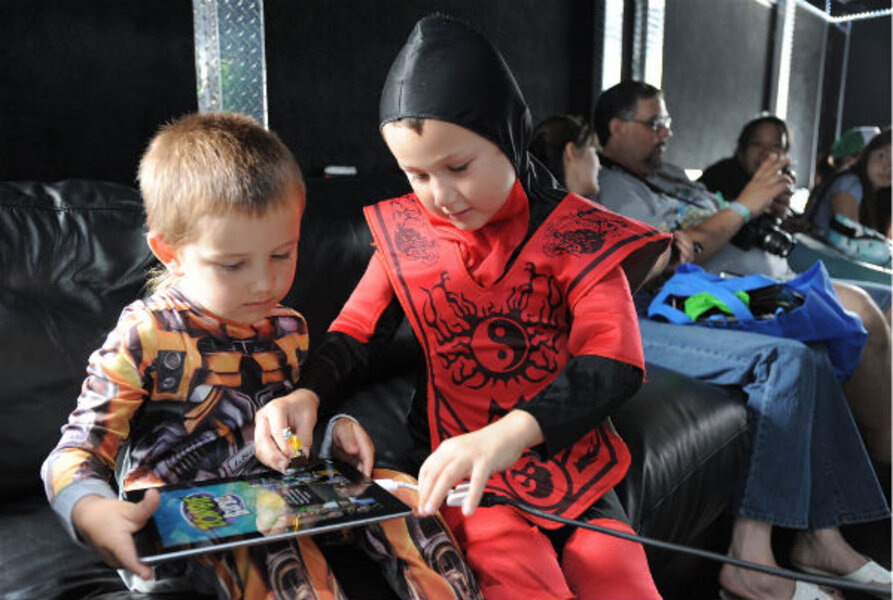Play gets short shrift in school; new media picks up slack
Loading...
A lightbulb went on when I read “Learning for a World of Constant Change” by authors John Seely Brown and Douglas Thomas. I think I understand now why there’s so much cognitive dissonance at the intersection of new media and learning, not to mention “online safety.” It has a lot to do with how media has changed, and parents and educators are still trying to catch up.
Media is no longer just something through which content is communicated, like a book, periodical, blackboard, TV set, etc. It’s not even just a tool for making things (like stories, videos, blogs, photos, etc.). It’s also an environment – but not just an environment around the acquiring of knowledge or for creating or expressing ourselves. It’s an environment for collaborating with others. And then not just collaborating but participating in something much larger than, say, a classroom project – participating in society. Media is a social context – an environment for participating in and changing the world.
Born playful, not digital
This is the media our kids and students work and play with. Then they go to school. [They're not born digitally literate – not at all – but they are born playful. They are born to learn through play, including social play. Though digital media is perfect for that, they're not digital natives, they're playful natives.]
Media has always been part of learning, but not the kind that’s just as bottom-up as top-down and one-to-many. To put it mildly, media as a set of creative tools and a social context that can be classroom-size or planet-spanning, depending on how you use it, is daunting to those of us schooled in the Industrial Age model of using mass media for mass production education. It’s easy to understand the cognitive dissonance being felt by teachers and most of the rest of their peers, including parents, schooled to teach approved, carefully crafted and packaged knowledge. Adding to it is students’ own cognitive dissonance around both the old kind of content and its mode of delivery (knowledge transfer). Because they can acquire knowledge on their own anytime, anywhere and because – now that media’s social – it’s contextual and participatory, they’re less and less comfortable with the knowledge-transfer mode of learning.
Parents’ tough dilemma
“We’re educating at what might well be the most change-filled, disruptive moment in education history,” writes dad, educator, and author Will Richardson. And yet – although many of us, including those who can’t afford private alternative schools, are cobbling together blends of traditional and Internet school, home study, and other alternatives – we have to send our kids to these places that tie up so much of their time “learning” information that’s less and less relevant to their futures (see this comment to Will’s post by Michele Bernhard).
So as a fellow parent of a high school student, I know exactly how Will feels about sending his kids off to school this year:
“I’m less and less confident that the emphasis of their time in school will be dedicated to inquiry, to exploring their passions, to helping them create real, meaningful work that lives in the world and just maybe changes it for the better. As much as their teachers might want that, the reality is as a system, we’ve hunkered down against any real innovation, cut budget and vision regarding technology, and decided to pursue the more traditional paths for “excellence” as in number of AP tests taken, high state test scores, SAT scores…whatever it takes to get us a high ranking in a state magazine’s annual list. It’s depressing.”
The solution: More play
What’s the solution? More play. We need to take a cue from our children, who are experts at learning through play, tinkering, messing around in everyday life and in and with digital social media, including games. According to the Pew Internet Project more than 97% of 12-to-17-year-olds play digital games (it was 97% in 2008) and, according to market researcher Ambient Insight, game-based learning will be a 2.3 billion market worldwide by 2017. We need more play – ideally, for better prep for living and working in a networked world, in digital environments – in school.
How can play be the solution? Play is what helps us (everybody, not only children) navigate both rapid change and complexity, according to John Seely Brown and Douglas Thomas. And why in digital media? “New media opens up the possibility of … deep knowing by providing the agency to participate, create and build,” they write. They talk about three kinds of learning practices that new media allows for: knowing, making, and playing. They correspond with three ways of being human, the write: homo sapiens (“[hu]man as knower”), homo faber (“[hu]man as maker”) and homo ludens (“[hu]man as player”) – that last one being “perhaps the most important, yet overlooked, element of understanding our relationship to new media.” Seely Brown and Thomas cite 20th-century Dutch cultural historian Johan Huizinga, who wrote the now more relevant than ever book Homo Ludens in the 1930s, as showing that “play is not something we do; it is who we are.” It’s certainly who our children are.
Play navigates rapid change, complexity
Play is all about learning as you go. Play in a fast-changing environment is like whitewater kayaking, a metaphor John Seely Brown uses – only social too, almost like a whitewater relay race! It develops personal and social agency and literacy on the fly, while individually and together processing and acting on the new information coming in every second. “Where traditional notions of learning position the learner as a passive agent of reception … play makes the agency of the player central to the learning process,” Seely Brown and Douglas write. “The value of play is never found in a static endpoint, but instead in the sense that the player is always in a state of becoming.” Think kayaker in Class 5 whitewater – a master of “becoming” – but then add the collaborative work of raids and other problem-solving activities in massively multiplayer online games.
So – in spite of adult concerns about digital distractions and too much “screen time” when there’s a ton of homework to be done – our children may intuitively know something we don’t know (or are beginning to see): that play, social interaction, and participation in digital spaces are preparing them for their futures at least as well as all those classes, homework assignments, and (even digital) textbooks at school. Maybe this is why Will Richardson, I and so many other parents have reservations about sending our kids off to school this year.
The Christian Science Monitor has assembled a diverse group of the best family and parenting bloggers out there. Our contributing and guest bloggers are not employed or directed by the Monitor, and the views expressed are the bloggers' own, as is responsibility for the content of their blogs. Anne Collier blogs at NetFamilyNews.






